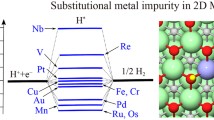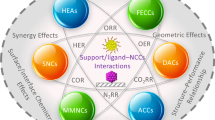Abstract
The catalytic decomposition of hydrazine using metallic nanoparticles has recently attracted considerable attention as this provides a promising means for highly efficient hydrogen release desired for a cleaner economy; however, the efficient catalytic nanoparticles model is still controversial. To shed further light on the optimal morphology of rhodium nanoparticles reported as the most efficient catalyst for this reaction, a more realistic nanocluster (Rhn) model is implemented here to compare the adsorption energies of hydrazine on these nanoclusters using the density functional theory. These nanoclusters (Rhn) comprise a varied number of Rh atom (n = 13–201), with their pre-constructed shapes but further defined by the highest energy optimization. Our calculations unravel that the vertex atoms of an Rhn nanocluster are the most favoured sites for N2H4 adsorption, in comparison with edge atoms or inner atoms of facets. Notably, the computed adsorption energies (Eads) clearly exhibit a linear dependence on their sizes effective particle diameter (r), with the equation Eads = − 1.30 + (− 0.24) r established. Further calculations on the introduction of adatoms to the regular nanoclusters demonstrated that the stepped facet plays a decisive role in determining the adsorption energy. Moreover, the electronic structure and charge transfer calculations revealed the dative-type binding nature of the N–Rh bond. These results highlight the importance of a more realistic particle model used for such adsorption studies and provide new insights into the design and development of nanocatalysts for the decomposition of hydrazine.







Similar content being viewed by others
References
Singh SK, Zhang X-B, Xu Q (2009) Room-temperature hydrogen generation from hydrous hydrazine for chemical hydrogen storage. J Am Chem Soc 131:9894–9895. https://doi.org/10.1021/ja903869y
Serov A, Padilla M, Roy AJ et al (2014) Anode catalysts for direct hydrazine fuel cells: from laboratory test to an electric vehicle. Angew Chem Int Ed 53:10336–10339. https://doi.org/10.1002/anie.201404734
Du Y, Su J, Luo W, Cheng G (2015) Graphene-supported nickel–platinum nanoparticles as efficient catalyst for hydrogen generation from hydrous hydrazine at room temperature. ACS Appl Mater Interfaces 7:1031–1034. https://doi.org/10.1021/am5068436
Li C, Wang T, Chu W, Wu P, Tong DG (2016) Synthesis of octahedral, truncated octahedral, and cubic Rh2Ni nanocrystals and their structure–activity relationship for the decomposition of hydrazine in aqueous solution to hydrogen. Nanoscale 8:7043–7055. https://doi.org/10.1039/c5nr09227b
Kang W, Varma A (2018) Hydrogen generation from hydrous hydrazine over Ni/CeO2 catalysts prepared by solution combustion synthesis. Appl Catal B Environ 220:409–416. https://doi.org/10.1016/j.apcatb.2017.08.053
Dai H, Qiu Y-P, Dai H-B, Wang P (2018) Ni–Pt/CeO2 loaded on granular activated carbon: an efficient monolithic catalyst for controlled hydrogen generation from hydrous hydrazine. ACS Sustain Chem Eng 6:9876–9882. https://doi.org/10.1021/acssuschemeng.8b01098
Chen J, Yao Q, Zhu J, Chen X, Lu Z-H (2016) Rh–Ni nanoparticles immobilized on Ce (OH) CO3 nanorods as highly efficient catalysts for hydrogen generation from alkaline solution of hydrazine. Int J Hydrog Energy 41:3946–3954. https://doi.org/10.1016/j.ijhydene.2015.12.158
Singh SK, Xu Q (2009) Complete conversion of hydrous hydrazine to hydrogen at room temperature for chemical hydrogen storage. J Am Chem Soc 131:18032–18033. https://doi.org/10.1021/ja908037t
Wang J, Zhang X-B, Wang Z-L, Wang L-M, Zhang Y (2012) Rhodium–nickel nanoparticles grown on graphene as highly efficient catalyst for complete decomposition of hydrous hydrazine at room temperature for chemical hydrogen storage. Energy Environ Sci 5:6885–6888. https://doi.org/10.1039/c2ee03344e
Zhang Z, Lu Z-H, Tan H, Chen X, Yao Q (2015) CeOx-modified RhNi nanoparticles grown on rGO as highly efficient catalysts for complete hydrogen generation from hydrazine borane and hydrazine. J Mater Chem A 3:23520–23529. https://doi.org/10.1039/c5ta06197k
Zhao P, Cao N, Luo W, Cheng G (2015) Nanoscale MIL-101 supported RhNi nanoparticles: an efficient catalyst for hydrogen generation from hydrous hydrazine. J Mater Chem A 3:12468–12475. https://doi.org/10.1039/c5ta02201k
He L, Liang B, Huang Y, Zhang T (2018) Design strategies of highly selective nickel catalysts for H2 production via hydrous hydrazine decomposition: a review. Natl Sci Rev 5:356–364. https://doi.org/10.1093/nsr/nwx123
Zeng H, Cheng X, Wang W (2018) A first-principles study on adsorption behaviors of pristine and Li-decorated graphene sheets toward hydrazine molecules. Appl Surf Sci 435:848–854. https://doi.org/10.1016/j.apsusc.2017.11.172
Yin H, Qiu Y-P, Dai H, Gan L-Y, Dai H-B, Wang P (2018) Understanding of selective H2 generation from hydrazine decomposition on Ni(111) Surface. J Phys Chem C 122:5443–5451. https://doi.org/10.1021/acs.jpcc.7b11293
Tafreshi SS, Roldan A, de Leeuw NH (2017) Micro-kinetic simulations of the catalytic decomposition of hydrazine on the Cu (111) surface. Faraday Discuss 197:41–57. https://doi.org/10.1039/c6fd00186f
Daff TD, Costa D, Lisiecki I, de Leeuw NH (2009) Density functional theory calculations of the interaction of hydrazine with low-index copper surfaces. J Phys Chem C 113:15714–15722. https://doi.org/10.1021/jp904054n
Daff TD, de Leeuw NH (2012) A density functional theory investigation of the molecular and dissociative adsorption of hydrazine on defective copper surfaces. J Mater Chem 22:23210–23220. https://doi.org/10.1039/c2jm34646j
Tafreshi SS, Roldan A, Dzade NY, de Leeuw NH (2014) Adsorption of hydrazine on the perfect and defective copper (111) surface: a dispersion-corrected DFT study. Surf Sci 622:1–8. https://doi.org/10.1016/j.susc.2013.11.013
Tafreshi SS, Roldan A, de Leeuw NH (2015) Density functional theory calculations of the hydrazine decomposition mechanism on the planar and stepped Cu (111) surfaces. Phys Chem Chem Phys 17:21533–21546. https://doi.org/10.1039/c5cp03204k
He YB, Jia JF, Wu HS (2015) The interaction of hydrazine with an Rh (1 1 1) surface as a model for adsorption to rhodium nanoparticles: a dispersion-corrected DFT study. Appl Surf Sci 327:462–469. https://doi.org/10.1016/j.apsusc.2014.12.007
Davis JB, Baletto F, Johnston RL (2015) The effect of dispersion correction on the adsorption of CO on metallic nanoparticles. J Phys Chem A 119:9703–9709. https://doi.org/10.1021/acs.jpca.5b05710
Kresse G, Hafner J (1994) Ab initio molecular-dynamics simulation of the liquid-metal–amorphous-semiconductor transition in germanium. Phys Rev B 49:14251–14269. https://doi.org/10.1103/PhysRevB.49.14251
Kresse G, Hafner J (1993) Ab initio molecular dynamics for liquid metals. Phys Rev B 47:558–561. https://doi.org/10.1103/PhysRevB.47.558
Kresse G, Furthmüller J (1996) Efficient iterative schemes for ab initio total-energy calculations using a plane-wave basis set. Phys Rev B 54:11169–11186. https://doi.org/10.1103/PhysRevB.54.11169
Kresse G, Furthmüller J (1996) Efficiency of ab initio total energy calculations for metals and semiconductors using a plane-wave basis set. Comput Mater Sci 6:15–50. https://doi.org/10.1016/0927-0256(96)00008-0
Kresse G, Joubert D (1999) From ultrasoft pseudopotentials to the projector augmented-wave method. Phys Rev B 59:1758–1775. https://doi.org/10.1103/PhysRevB.59.1758
Blöchl PE (1994) Projector augmented-wave method. Phys Rev B 50:17953–17979. https://doi.org/10.1103/PhysRevB.50.17953
Perdew JP, Burke K, Ernzerhof M (1997) Generalized gradient approximation made simple [Phys. Rev. Lett. 77, 3865 (1996)]. Phys Rev Lett 78:1396. https://doi.org/10.1103/physrevlett.78.1396
Perdew JP, Burke K, Ernzerhof M (1996) Generalized gradient approximation made simple. Phys Rev Lett 77:3865–3868. https://doi.org/10.1103/PhysRevLett.77.3865
Štich I, Car R, Parrinello M, Baroni S (1989) Conjugate gradient minimization of the energy functional: a new method for electronic structure calculation. Phys Rev B 39:4997–5004. https://doi.org/10.1103/PhysRevB.39.4997
Kittel C (2005) Introduction to solid state physics. Wiley, New York
Momma K, Izumi F (2011) VESTA 3 for three-dimensional visualization of crystal, volumetric and morphology data. J Appl Crystallogr 44:1272–1276. https://doi.org/10.1107/S0021889811038970
Grimme S, Ehrlich S, Goerigk L (2011) Effect of the damping function in dispersion corrected density functional theory. J Comput Chem 32:1456–1465. https://doi.org/10.1002/jcc.21759
Grimme S, Antony J, Ehrlich S, Krieg H (2010) A consistent and accurate ab initio parametrization of density functional dispersion correction (DFT-D) for the 94 elements H-Pu. J Chem Phys 132:154104-1–154104-19. https://doi.org/10.1063/1.3382344
Peng G, Mavrikakis M (2015) Adsorbate diffusion on transition metal nanoparticles. Nano Lett 15:629–634. https://doi.org/10.1021/nl504119j
An W, Liu P (2015) Rationalization of Au concentration and distribution in AuNi@ Pt core–shell nanoparticles for oxygen reduction reaction. ACS Catal 5:6328–6336. https://doi.org/10.1021/acscatal.5b01656
Tafreshi SS, Roldan A, de Leeuw NH (2014) Density functional theory study of the adsorption of hydrazine on the perfect and defective copper (100), (110), and (111) surfaces. J Phys Chem C 118:26103–26114. https://doi.org/10.1021/jp5078664
He YB, Jia JF, Wu HS (2015) First-principles investigation of the molecular adsorption and dissociation of hydrazine on Ni–Fe alloy surfaces. J Phys Chem C 119:8763–8774. https://doi.org/10.1021/acs.jpcc.5b01605
Chen JG, Menning CA, Zellner MB (2008) Monolayer bimetallic surfaces: experimental and theoretical studies of trends in electronic and chemical properties. Surf Sci Rep 63:201–254. https://doi.org/10.1016/j.surfrep.2008.02.001
An W, Liu P (2013) Size and shape effects of Pd@ Pt core–shell nanoparticles: unique role of surface contraction and local structural flexibility. J Phys Chem C 117:16144–16149. https://doi.org/10.1021/jp4057785
Filot IAW, Shetty SG, Hensen EJM, van Santen RA (2011) Size and topological effects of rhodium surfaces, clusters and nanoparticles on the dissociation of CO. J Phys Chem C 115:14204–14212. https://doi.org/10.1021/jp201783f
Kitchin JR, Norskov JK, Barteau MA, Chen JG (2004) Modification of the surface electronic and chemical properties of Pt (111) by subsurface 3d transition metals. J Chem Phys 120:10240–10246. https://doi.org/10.1063/1.1737365
Pallassana V, Neurock M, Hansen LB, Nørskov JK (2000) First principles analysis of hydrogen chemisorption on Pd–Re alloyed overlayers and alloyed surfaces. J Chem Phys 112:5435–5439. https://doi.org/10.1063/1.481119
Yudanov IV, Genest A, Schauermann S, Freund HJ, Rosch N (2012) Size dependence of the adsorption energy of CO on metal nanoparticles: a DFT search for the minimum value. Nano Lett 12:2134–2139. https://doi.org/10.1021/nl300515z
Acknowledgements
This work is financially supported by the National Natural Science Foundation of China (21571119), Australian Research Council (DP180101581), the Scientific and Technological Innovation Programs of Higher Education Institutions in Shanxi (STIP) (2016174) and the Doctoral Scientific Research Foundation of Changzhi Medical College (BS15014).
Author information
Authors and Affiliations
Corresponding authors
Additional information
Publisher's Note
Springer Nature remains neutral with regard to jurisdictional claims in published maps and institutional affiliations.
Electronic supplementary material
Below is the link to the electronic supplementary material.
Rights and permissions
About this article
Cite this article
He, Y., Yu, J., Wu, H. et al. Defining the optimal morphology of Rhn nanoparticles for efficient hydrazine adsorption: a DFT-D3 study. J Mater Sci 54, 9533–9542 (2019). https://doi.org/10.1007/s10853-019-03579-5
Received:
Accepted:
Published:
Issue Date:
DOI: https://doi.org/10.1007/s10853-019-03579-5




